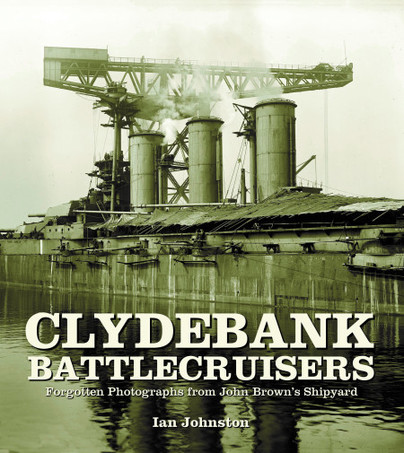
Clydebank Battlecruisers; Forgotten Photography from John Brown’s Shipyard. By Ian Johnston. Seaforth Publishing, Barnsley, South Yorkshire, 2023.
Reviewed by Tim Coyle
BUY NOW FROM BOOKTOPIA
The cover photograph of Clydebank Battlecruisers shows a portside view of HMS Tiger in the John Brown fitting out basin on the River Clyde, Glasgow, on 17 August 1914, six weeks before completion. Framed by the 150-ton cantilever crane, Tiger’s three funnels exude wisps of steam.
The upper deck, aft of the foremast, is covered by a vast canvas to protect workers from the weather as the shipyard strained to meet the Admiralty’s demand to expedite the ship’s completion to join the Grand Fleet. The ship’s side is besmirched by shipyard grime. A later double-page spread shows a three quarter bow view of the pristine ship on 03 October undergoing trials before joining the 1st Battle Cruiser Squadron on 06 November 1914 at Scapa Flow.
Twenty-one pages of superb prints, taken from glass 10 x 12 inch plate negatives, depict Tiger’s construction. These, as with all the photographs in the book, were taken by the John Brown & Co. Ltd five-man photographic team, which recorded ships’ construction progress from keel-laying to trials. The shipyard built naval and merchant ships of all sizes (including the liners Aquitania and Queen Mary) -a history of which is found in Ships for All Nations; John Brown and Company Clydebank 1847 – 1971 (Seaforth Publishing 2015), also by Ian Johnston.
John Brown built five battlecruisers – HM Ships Inflexible, Tiger, Repulse, Hood and HMAS Australia – between 1907 and 1920. These ships represented the British battlecruiser generation conceived in the fertile brain of First Sea Lord John Fisher who envisaged fast all-big guns capital ships with lighter armour than his ‘first-born’ dreadnought battleships, designed to hit hard and fast in advance of the battle fleet. The John Brown battlecruisers were every bit as spectacular as the battleships, but with added panache as exemplified in the superb Hood, lost through lack of protective armour in May 1941.
Capturing the ships’ construction on glass plate negatives was a considerable undertaking. The glass plate large format cameras were large and cumbersome on heavy tripods which the photographer had to position in often precarious locations on ships’ upperworks and cranes. While the slow emulsions required time exposures, risking blurring of movement, a correct exposure delivered a spectacularly detailed print. Photographic albums were given to shipowners and the Admiralty as records of their ships’ constructions as well as for company publicity.
The construction progress for each ship is depicted in over twenty pages of photographs – many full page – while Hood has forty-five pages. Texts supporting the images detail design, contractual, Admiralty correspondence, drawing office and engineering aspects. The workmanlike characteristics of the photographs is reflected in the lack of ‘formal’ images – no launching ceremonies or distinguished guests. Shipyard personnel and ships’ companies are shown going about their duties in building and preparing the ships for departure. Anyone who has had an association with dockyards will feel an affinity for the timeless activities in the photographs.
While many photographs are taken at the work sites on board or in fabrication workshops, many others show the ships on the building ways and in the fitting out basins with abundant collateral detail of the shipyard facilities. A particular contrast is the verdant, open countryside on the opposite bank of the Clyde River which is visible in many wide-angle shots.
Australian readers will relish the coverage of HMAS Australia. A series of photographs, probably taken close to departure, show many of the ship’s company mustered on the upper deck in No.1 uniform; in the character of the ‘workmanlike’ flavour they are not ‘fallen in’ but stand in informal lines, possibly having just arrived on board. One might imagine the excitement these young Australians must have felt, about to sail their mighty ship to its homeland for the first time to be greeted by thousands of navy-minded citizens when the battlecruiser, named for their country, entered Sydney Harbour, together with the rest of the ”Fleet Unit’, on 04 October 1913.
The survival of this magnificent archive is remarkable. It depicts the state of British shipbuilding at its highest point of the past industrial age. The clarity and drama of the monotone large-format prints are a delight and may be enjoyed repeatedly due to the myriad details of shipyard which capture the eye with its complexity and drama. Ian Johnston has produced a fine tribute to the John Brown workers and the ships’ companies of the magnificient battlecruisers.
(Ian Buxton also authored A Shipyard at War; Unseen Photographs from John Brown’s, Clydebank 1914-1918 – Seaforth Publishing 2014). Here may be seen all manner of warships under construction).



